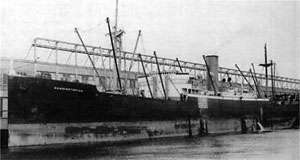 Washingtonian in port, about 1914
| |
| History | |
|---|---|
| Name | Washingtonian |
| Owner | American-Hawaiian Steamship Company |
| Ordered | September 1911[2] |
| Builder | |
| Yard number | 131[3] |
| Launched | 11 October 1913[4] |
| Completed | 16 January 1914[3] |
| Identification |
|
| Fate | Sunk in collision, 26 January 1915 |
| General characteristics | |
| Type | refrigerated cargo ship |
| Tonnage | 6,650 GRT, 4,064 NRT[5] 10,250 LT DWT[1] |
| Length | 407.7 ft (124.3 m)[5] (LPP) |
| Beam | 43.7 ft (13.3 m)[5] |
| Depth | 36.1 ft (11.0 m)[5] |
| Installed power | 704 NHP[5] |
| Propulsion |
|
| Speed | 12.5 knots (23 km/h)[4] |
| Capacity | 490,858 cubic feet (13,900 m3)[1] |
| Crew | 40[7] |
| Notes | Sister ships: Minnesotan, Dakotan, Montanan, Pennsylvanian, Panaman, Iowan, Ohioan[3] |
SS Washingtonian was a refrigerated cargo ship launched in 1913 by the Maryland Steel of Sparrows Point, Maryland, near Baltimore, as one of eight sister ships for the American-Hawaiian Steamship Company. When completed, she was the largest cargo ship in the US registry. During the United States occupation of Veracruz in April 1914, Washingtonian was chartered by the United States Department of the Navy for service as a non-commissioned refrigerated supply ship for the US fleet stationed off the Mexican coast.
In January 1915, after a little more than one year of service, Washingtonian collided with the schooner Elizabeth Palmer off the Delaware coast and sank in ten minutes with the loss of her $1,000,000 cargo of 10,000 long tons (10,200 t) of raw Hawaiian sugar. In the days after Washingtonian's sinking, the price of sugar in the United States increased almost nine percent, partly attributed to the loss of Washingtonian's cargo. Lying under about 100 feet (30 m) of water, Washingtonian's wreck is one of the most popular recreational dive sites on the eastern seaboard.
- ^ a b c Cite error: The named reference
Cochran-365was invoked but never defined (see the help page). - ^ Cochran and Ginger, p. 358.
- ^ a b c Colton, Tim. "Bethlehem Steel Company, Sparrows Point MD". Shipbuildinghistory.com. The Colton Company. Archived from the original on October 8, 2008. Retrieved 12 August 2008.
{{cite web}}: CS1 maint: unfit URL (link) - ^ a b "Washingtonian". Miramar Ship Index. R. B. Haworth. Retrieved 12 August 2008.(subscription required)
- ^ a b c d e f g h i Lloyd's Register 1914, WAS.
- ^ Cochran and Ginger, p. 357.
- ^ "Big ship sinks in crash". The Washington Post. 27 January 1915. p. 3.